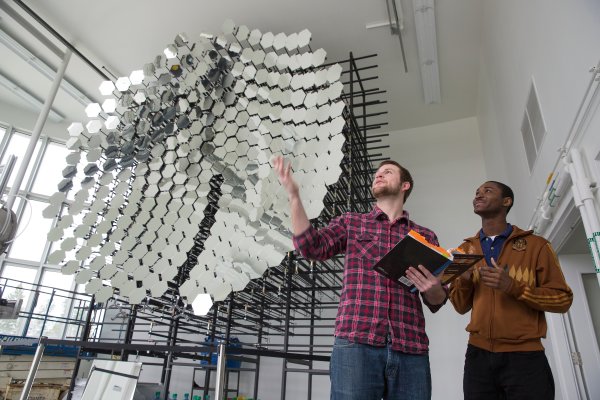College of Engineering Computer Recommendations
2024-25 Academic Year
These recommendations should serve as guidelines for new PC purchases, but are not absolute. Purchase a desktop or laptop computer based on your needs and circumstances. E-mail any questions you have about computer purchases to helpdesk@valpo.edu.
These specifications are specific to students in the College of Engineering. For general recommendations please visit the IT department’s Computer Specifications page.
PC VS. MAC
Some of our students prefer Mac over PC, and that is completely fine! In the College of Engineering, our environment consists almost entirely of PCs, because the vast majority of engineering software is written for Windows. There are some software vendors that offer free student versions, but many of them can only be used in the computer labs because they require a lab license. If you want to run student versions on your own computer, a PC is recommended.
ENTERPRISE VS. CONSUMER GRADE
Most computer manufacturers have two types of models they sell. Dell’s Inspiron, Lenovo’s Ideapad, and HP’s Spectre are all consumer-grade models. They use cheaper parts which change more frequently within a single model year, and are more difficult and costly to repair. Dell Latitude, Lenovo ThinkPad, and HP ProBook are all enterprise-grade laptops. If possible, opt for an enterprise-grade model when making your computer-buying decision.
PROCESSOR
At a minimum, an Intel i5 or AMD Ryzen 5 processor is recommended. If you or your student are planning to run CAD applications like AutoCAD or SolidWorks, an i7 or Ryzen 7 processor is a better choice. Battery life is an important trade-off to consider when selecting a processor; a more powerful processor will use battery more quickly. Many laptops with higher-end processors will include a larger battery to compensate, but be sure to check your laptop’s rated battery life to ensure it will fit your needs.
MEMORY
Memory (also called RAM, or random-access memory) is where your computer stores short-term data that it uses for loading the operating system and running programs. The minimum requirement for fast performance in a laptop or desktop computer is 8 gigabytes (GB). Recently 16GB has started to become more common in new computers, which means they are capable of booting into Windows/macOS and loading programs more quickly.
Note: The term “memory” is often used to refer to how much storage a computer has, but in the IT field it is used exclusively when referring to RAM.
STORAGE
There are two basic types of storage to choose from: traditional hard disk drives (HDDs) and faster solid-state drives (SSDs). We recommend computers that have solid-state drives. Storage has traditionally been a performance bottleneck for computers, but SSDs have changed this conventional wisdom, offering real-world speed increases of 2x or more! You will often see PCIe, M.2, and NVMe in reference to a solid-state drive. These all refer to the same thing.
The only drawback to buying a laptop with an SSD is that HDDs typically offer larger storage quantities. If you need more storage than what an SSD includes, a nano flash drive (like this Sandisk model) or an external hard disk drive (like this one from Western Digital) can be used in conjunction with the built-in SSD. This way you benefit from having a fast boot disk while still having enough storage to hold larger files.
GRAPHICS
Graphics are one of the most difficult things to consider when buying a new computer, because manufacturers often do not quantify performance when listing specs. Sometimes a computer maker will just list “Intel Iris Xe Graphics”, without detailing the performance of the chipset. When you see this, it means the graphics processing unit (GPU) is integrated into the same chipset as the central processing unit (CPU). These graphics processors are very efficient in terms of power usage, but they are not high-performance. These integrated GPUs are sufficient for most engineering applications, but are not well-suited to gaming.
If you or your student wants to use a laptop or desktop for gaming, a better option is a computer with a discrete graphics card. This GPU is a standalone unit, separate from the CPU, and is designed to handle graphically intensive tasks at higher framerates. Generally if a laptop is advertised as a Gaming Laptop, it will include a discrete GPU.
SOFTWARE
An office productivity suite is suggested. All Valpo students have access to the Microsoft Office suite free of charge. (See the Engineering Software page for details about how to download and install Office 365.) Valpo students also have access to Google Docs through their Valpo accounts, along with expanded storage in Google Drive.
Some of the engineering-specific software that students use in labs can also be installed on personal computers. AutoCAD and MATLAB are two such programs that are available to Valpo students for personal use. For more information, visit the College’s Software for Students page linked in the paragraph above.
WHERE TO BUY
Valparaiso University counts CDW-G as one of its vendors for sourcing computers and related equipment. Students are now eligible for the same academic pricing through CDW-G that the school receives! To purchase a computer from this vendor, follow the link here: http://www.cdwg.com/valpo.
Most manufacturers, including Dell, Lenovo, HP, Apple, and others, offer education discounts (usually around 10%). Typically all you will need to prove your affiliation with an educational institution is your valpo.edu e-mail address.
